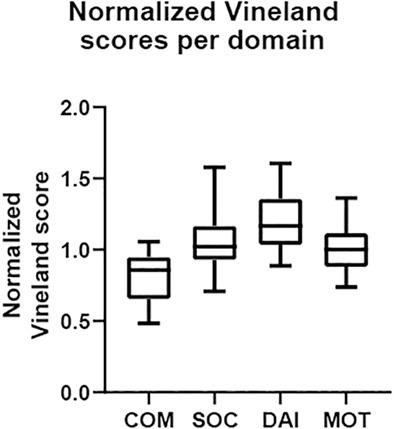当前位置:
X-MOL 学术
›
Genes Brain Behav.
›
论文详情
Our official English website, www.x-mol.net, welcomes your feedback! (Note: you will need to create a separate account there.)
Speech-language profiles in the context of cognitive and adaptive functioning in SATB2-associated syndrome
Genes, Brain and Behavior ( IF 2.5 ) Pub Date : 2021-07-09 , DOI: 10.1111/gbb.12761 Lot Snijders Blok 1, 2, 3 , Y Max Goosen 4 , Leenke van Haaften 3, 5 , Karen van Hulst 3, 5 , Simon E Fisher 2, 6 , Han G Brunner 1, 3, 7 , Jos I M Egger 4, 8, 9 , Tjitske Kleefstra 1, 3, 4
Genes, Brain and Behavior ( IF 2.5 ) Pub Date : 2021-07-09 , DOI: 10.1111/gbb.12761 Lot Snijders Blok 1, 2, 3 , Y Max Goosen 4 , Leenke van Haaften 3, 5 , Karen van Hulst 3, 5 , Simon E Fisher 2, 6 , Han G Brunner 1, 3, 7 , Jos I M Egger 4, 8, 9 , Tjitske Kleefstra 1, 3, 4
Affiliation

|
SATB2-associated syndrome (SAS) is a neurodevelopmental disorder caused by heterozygous pathogenic variants in the SATB2 gene, and is typically characterized by intellectual disability and severely impaired communication skills. The goal of this study was to contribute to the understanding of speech and language impairments in SAS, in the context of general developmental skills and cognitive and adaptive functioning. We performed detailed oral motor, speech and language profiling in combination with neuropsychological assessments in 23 individuals with a molecularly confirmed SAS diagnosis: 11 primarily verbal individuals and 12 primarily nonverbal individuals, independent of their ages. All individuals had severe receptive language delays. For all verbal individuals, we were able to define underlying speech conditions. While childhood apraxia of speech was most prevalent, oral motor problems appeared frequent as well and were more present in the nonverbal group than in the verbal group. For seven individuals, age-appropriate Wechsler indices could be derived, showing that the level of intellectual functioning of these individuals varied from moderate–mild ID to mild ID-borderline intellectual functioning. Assessments of adaptive functioning with the Vineland Screener showed relatively high scores on the domain “daily functioning” and relatively low scores on the domain “communication” in most individuals. Altogether, this study provides a detailed delineation of oral motor, speech and language skills and neuropsychological functioning in individuals with SAS, and can provide families and caregivers with information to guide diagnosis, management and treatment approaches.
中文翻译:

SATB2相关综合征认知和适应功能背景下的语言特征
SATB2相关综合征(SAS)是一种由SATB2杂合致病变异引起的神经发育障碍。基因,并且通常以智力残疾和严重受损的沟通技巧为特征。本研究的目的是在一般发展技能以及认知和适应功能的背景下,有助于理解 SAS 中的言语和语言障碍。我们结合神经心理学评估对 23 名分子确认为 SAS 的人进行了详细的口腔运动、言语和语言分析:11 名主要是语言的人,12 名主要是非语言的人,与他们的年龄无关。所有个体都有严重的接受性语言延迟。对于所有言语个体,我们能够定义潜在的言语条件。虽然儿童时期的言语失用最为普遍,口腔运动问题也很常见,并且在非语言组中比在语言组中更多。对于 7 个人,可以得出适合年龄的 Wechsler 指数,表明这些人的智力功能水平从中度至轻度 ID 到轻度 ID 边界智力功能不等。在大多数人中,使用 Vineland Screener 对适应性功能的评估显示在“日常功能”领域的得分相对较高,而在“沟通”领域的得分相对较低。总之,本研究详细描述了 SAS 患者的口腔运动、言语和语言技能以及神经心理功能,并可以为家庭和护理人员提供指导诊断、管理和治疗方法的信息。可以推导出适合年龄的 Wechsler 指数,表明这些人的智力功能水平从中度至轻度 ID 到轻度 ID 边缘智力功能不等。在大多数人中,使用 Vineland Screener 对适应性功能的评估显示在“日常功能”领域的得分相对较高,而在“沟通”领域的得分相对较低。总之,本研究详细描述了 SAS 患者的口腔运动、言语和语言技能以及神经心理功能,并可以为家庭和护理人员提供指导诊断、管理和治疗方法的信息。可以推导出适合年龄的 Wechsler 指数,表明这些人的智力功能水平从中度至轻度 ID 到轻度 ID 边缘智力功能不等。在大多数人中,使用 Vineland Screener 对适应性功能的评估显示在“日常功能”领域的得分相对较高,而在“沟通”领域的得分相对较低。总之,本研究详细描述了 SAS 患者的口腔运动、言语和语言技能以及神经心理功能,并可以为家庭和护理人员提供指导诊断、管理和治疗方法的信息。表明这些人的智力功能水平从中度-轻度 ID 到轻度 ID 边缘智力功能不等。在大多数人中,使用 Vineland Screener 对适应性功能的评估显示在“日常功能”领域的得分相对较高,而在“沟通”领域的得分相对较低。总之,本研究详细描述了 SAS 患者的口腔运动、言语和语言技能以及神经心理功能,并可以为家庭和护理人员提供指导诊断、管理和治疗方法的信息。表明这些人的智力功能水平从中度-轻度 ID 到轻度 ID 边缘智力功能不等。在大多数人中,使用 Vineland Screener 对适应性功能的评估显示在“日常功能”领域的得分相对较高,而在“沟通”领域的得分相对较低。总之,本研究详细描述了 SAS 患者的口腔运动、言语和语言技能以及神经心理功能,并可以为家庭和护理人员提供指导诊断、管理和治疗方法的信息。
更新日期:2021-09-14
中文翻译:

SATB2相关综合征认知和适应功能背景下的语言特征
SATB2相关综合征(SAS)是一种由SATB2杂合致病变异引起的神经发育障碍。基因,并且通常以智力残疾和严重受损的沟通技巧为特征。本研究的目的是在一般发展技能以及认知和适应功能的背景下,有助于理解 SAS 中的言语和语言障碍。我们结合神经心理学评估对 23 名分子确认为 SAS 的人进行了详细的口腔运动、言语和语言分析:11 名主要是语言的人,12 名主要是非语言的人,与他们的年龄无关。所有个体都有严重的接受性语言延迟。对于所有言语个体,我们能够定义潜在的言语条件。虽然儿童时期的言语失用最为普遍,口腔运动问题也很常见,并且在非语言组中比在语言组中更多。对于 7 个人,可以得出适合年龄的 Wechsler 指数,表明这些人的智力功能水平从中度至轻度 ID 到轻度 ID 边界智力功能不等。在大多数人中,使用 Vineland Screener 对适应性功能的评估显示在“日常功能”领域的得分相对较高,而在“沟通”领域的得分相对较低。总之,本研究详细描述了 SAS 患者的口腔运动、言语和语言技能以及神经心理功能,并可以为家庭和护理人员提供指导诊断、管理和治疗方法的信息。可以推导出适合年龄的 Wechsler 指数,表明这些人的智力功能水平从中度至轻度 ID 到轻度 ID 边缘智力功能不等。在大多数人中,使用 Vineland Screener 对适应性功能的评估显示在“日常功能”领域的得分相对较高,而在“沟通”领域的得分相对较低。总之,本研究详细描述了 SAS 患者的口腔运动、言语和语言技能以及神经心理功能,并可以为家庭和护理人员提供指导诊断、管理和治疗方法的信息。可以推导出适合年龄的 Wechsler 指数,表明这些人的智力功能水平从中度至轻度 ID 到轻度 ID 边缘智力功能不等。在大多数人中,使用 Vineland Screener 对适应性功能的评估显示在“日常功能”领域的得分相对较高,而在“沟通”领域的得分相对较低。总之,本研究详细描述了 SAS 患者的口腔运动、言语和语言技能以及神经心理功能,并可以为家庭和护理人员提供指导诊断、管理和治疗方法的信息。表明这些人的智力功能水平从中度-轻度 ID 到轻度 ID 边缘智力功能不等。在大多数人中,使用 Vineland Screener 对适应性功能的评估显示在“日常功能”领域的得分相对较高,而在“沟通”领域的得分相对较低。总之,本研究详细描述了 SAS 患者的口腔运动、言语和语言技能以及神经心理功能,并可以为家庭和护理人员提供指导诊断、管理和治疗方法的信息。表明这些人的智力功能水平从中度-轻度 ID 到轻度 ID 边缘智力功能不等。在大多数人中,使用 Vineland Screener 对适应性功能的评估显示在“日常功能”领域的得分相对较高,而在“沟通”领域的得分相对较低。总之,本研究详细描述了 SAS 患者的口腔运动、言语和语言技能以及神经心理功能,并可以为家庭和护理人员提供指导诊断、管理和治疗方法的信息。


























 京公网安备 11010802027423号
京公网安备 11010802027423号